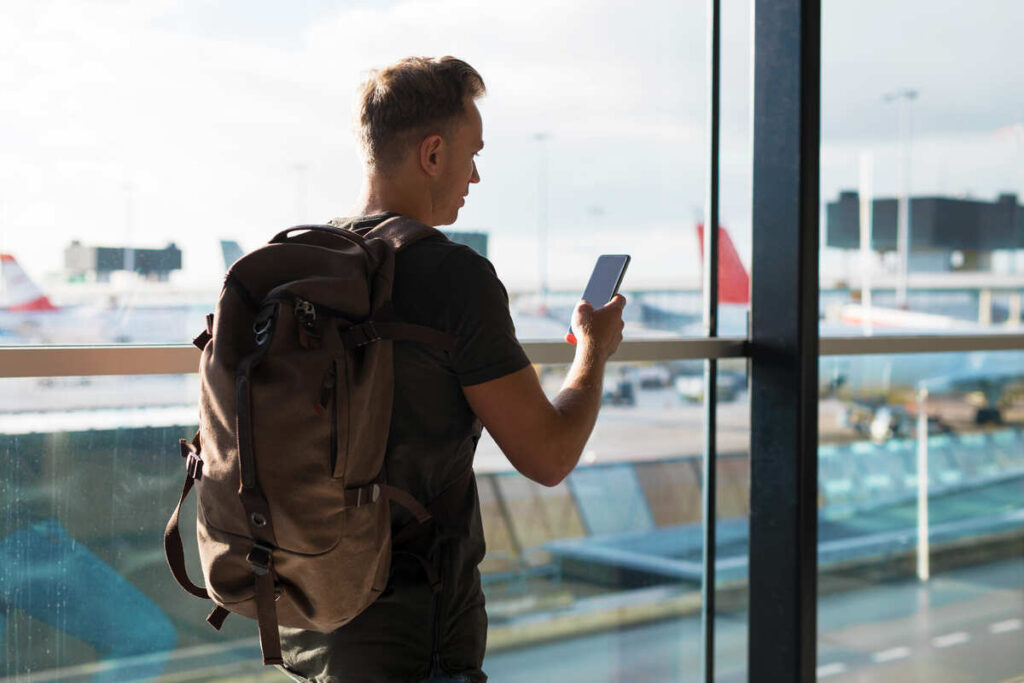No products in the cart.
Travel Guide
Apple’s New iPhone 14 Will Pose A Problem For American Travelers
Last Updated
This week, Apple finally unveiled its long anticipated iPhone 14, and like every other year, it includes camera updates and strengthened safety measures. However, one tiny detail missing this year may pose a big problem for travelers that are avid iPhone customers: the new smartphone does not have Apple’s signature SIM card tray.

When traveling, American tourists generally prefer buying a local SIM as opposed to activating international roaming, reason being fees for data usage abroad can be eye-watering. With previous iPhones, buying a data package and inserting a new temporary SIM was an incredibly smooth process, so long as a pin needle was at hand.
Now, Apple has made SIM swapping slightly more complicated:
What’s Wrong With Apple’s New iPhone?

During its Far Out event, Apple finally presented to the public its new iPhone series, comprising four new smartphone models: iPhone 14, iPhone 14 Plus, and its flagship iPhone 14 Pro and iPhone 14 Pro Max. In case you’re interested in tech specs, you can find more information about each model on the company’s website, but there’s one thing that affects travelers directly:
The product has lost their physical SIM tray and buyers are expected to take out an eSIM data plan instead. While this shouldn’t be an impediment within the U.S., with T&T, Verizon and T-Mobile all offering the service, accessing data in foreign countries where the technology isn’t widely diffused may prove more difficult from now.

When traveling internationally, especially remote or off path destinations, it is extremely difficult to find kiosks selling digital data packages. Usually, tourists are required to remove their own SIM and insert a secondary, albeit temporary one. They’re usually pre-paid as well, meaning the sharing of personal information is minimal and there’s little bureaucracy involved.
Once the standard iPhone 14 debuts, the SIM-swapping process is due to change significantly. That is because some destinations may not have eSIM packages designed for tourists, or even have eSIMs at all. This shouldn’t be a problem in North America or Europe, but this might become a thorn on the side of those heading to less developed nations:
eSIMs Are Not Widely Available In Some Major Destinations Yet

In Brazil, for instance, eSIMs are in theory sold by the country’s three main data providers, VIVO, Claro and TIM, though in reality, finding stores where they’re offered is challenging at the very least. In Brazil’s case, eSIMs are routinely available on a contract-basis only, or staff may not even be familiar with the product, let alone be able to assist visitors.
In other Latin American hotspots, such as Argentina and Colombia, pre-paid eSIMs can be purchased directly from internet providers such as Movistar, though it is a well-known fact not all stores across these countries commercialize the product. Additionally, countless nations across Asia and Africa are yet to launch them.

Based on Apple’s official list of countries whose carriers support eSIM carrier activation, traveling with an iPhone 14 shouldn’t be a problem in:
- Albania
- Armenia
- Argentina
- Australia
- Austria*
- Bahamas
- Bahrain
- Belarus
- Belgium
- Brazil*
- Bulgaria
- Burkina Faso
- Cambodia
- Cameroon
- Canada
- Chile
- Colombia
- Croatia
- Czech Republic
- Denmark
- Ecuador
- Estonia
- Finland
- France
- French West Indies
- Germany
- Greece
- Guam
- Hong Kong
- Hungary
- Iceland
- India
- Ireland
- Italy
- Japan
- Jordan
- Kazakhstan
- Kuwait
- Latvia
- Lebanon
- Lithuania
- Luxembourg
- Macao
- Malaysia
- Maldives
- Malta
- Mexico
- Moldova
- Montenegro
- Morocco
- Netherlands
- New Zealand
- North Macedonia
- Norway
- Oman
- Pakistan
- Palestine
- Philippines
- Poland
- Portugal
- Qatar
- Romania
- Saudi Arabia
- Senegal
- Serbia
- Singapore
- Slovakia
- Slovenia
- South Africa
- South Korea
- Spain
- Sri Lanka
- Sweden
- Switzerland
- Taiwan
- Tajikistan
- Thailand
- Tunisia
- Turkyie (Turkey)
- Ukraine
- United Arab Emirates
- United Kingdom
- United States
- Vietnam
*Under EU roaming rules, customers can use data freely within the entire European Zone, which includes European Union countries, Schengen Area members, and other third partners such as Serbia and Montenegro, though different rules may apply to pre-paid SIMs.
**It is worth noting that, although certain countries are listed, eSIMs may be difficult to find, as is the case in Brazil.

Alternatively, iPhone users can resort to ‘worldwide’ eSIMs, international data packages that are valid across the entire globe, such as Airalo, AirSIM, GigSKY, Flexiroam and others. Travelers are usually required to download an app, choose their destination and product, install the SIM and activate it upon landing.
We do not know, at this point, how well these global packages work, or how fast and reliable they are compared to local providers.
Apple’s Move Is Received With Mixed Reactions On Twitter
Naturally, frequent travelers decried Apple’s move, with dozens taking to Twitter to express concern the transition period from ‘physical to digital’ will be rough:
As can be seen above, travelers are worried they will not be able to activate eSIMs as easily as simply purchasing a local SIM from regular kiosks at their destination, with one Twitter user drawing attention to the fact that, in India, the process of buying a data package from a carrier store can be ‘days long’ and ‘bureaucratic’.

Two Ways You Can Still Have A Physical SIM Card While Upgrading Your iPhone
Apple’s iPhone 14 may lack many deem an essential characteristic, but it does allow up to eight eSIMs simultaneously. Even then, if you’re looking to upgrade your phone this year, yet still avoid being restricted to eSIMs only, you have two options:
- Purchasing an iPhone 14 outside the U.S., as it is the only country where Apple scrapped the trays*
- Opting instead for last year’s iPhone 13 or 13 Pro range which features a SIM card tray, giving customers more flexibility

*In an interview with PC Mag, Avi Greengart, Techsponential’s lead analyst stated that the ‘rationale’ for keeping the SIM slot in non-U.S. markets, particularly Europe, is the ‘sheer number of people using prepaid SIMs’. This may be due to the high volume of cross-border travel and facilitated international links within the continent.
It remains to be seen how well-tolerated these new iPhones will be in the context of international travel, though we will surely find out soon.
Read More:
Travel Insurance That Covers Covid-19 For 2022
Caribbean Destinations With No Restrictions This Fall & Winter
Cancun Vs. Punta Cana: Which Is The Best All Inclusive Destination?
Americans Will Need To Complete New Travel Form To Visit Jamaica
This Is The Only Country In South America That Has Dropped All Travel Restrictions
This article originally appeared on Travel Off Path. For the latest breaking news that will affect your next trip, please visit: Traveloffpath.com
↓ Join the community ↓
The Travel Off Path Community FB group has all the latest reopening news, conversations, and Q&A’s happening daily!

SUBSCRIBE TO OUR LATEST POSTS
Enter your email address to subscribe to Travel Off Path’s latest breaking travel news, straight to your inbox
Disclaimer: Current travel rules and restrictions can change without notice. The decision to travel is ultimately your responsibility. Contact your consulate and/or local authorities to confirm your nationality’s entry and/or any changes to travel requirements before traveling. Travel Off Path does not endorse traveling against government advisories

